The All-Too-Common Mistakes People Make With Thanksgiving Turkey
Everything Thanksgiving: Get all our Thanksgiving recipes, how-to’s and more!
Thanksgiving only comes once a year, which means there aren’t many chances to practice cooking up a Thanksgiving turkey ― and that often spells disaster. But if you study up and learn about the basics of cooking a turkey, you can totally pull it off.
We’re here to warn you of all the possible pitfalls ― so do your homework, and you won’t have to worry about committing one of the many mistakes that have become all too common.
Below, we’re presenting all the ways a turkey can go wrong in your kitchen and how to these mistakes can be easily avoided. It’s really easy once you know what you’re doing, we promise.
Read up, and you’ll be fine come the big day.
*Note: The USDA recommends all turkeys be cooked to at least 165 degrees Fahrenheit for optimum safety. You’ll notice below that we often suggest removing the bird from the oven when it reaches 160, but that’s because the bird’s temperature will continue to rise to 165 (or above) after you remove it from the oven. Just make sure it ultimately reaches 165.

Alamy
Problem: It's hard to know when the turkey is done.
Solution: It's time to get yourself a trusty instant-read thermometer and take the turkey's temperature. Just insert a meat thermometer into the area where the thigh and breast meet -- it should register 160 degrees F when it's removed from the oven, and 165 degrees F after it has rested. If you've stuffed the bird, take the temperature of the stuffing (160 to 165 degrees F also). You can also make an incision where the thigh and breast meet -- if the juices run clear, not red, then the bird is done. Whatever you do, don't rely on those plastic pop-up timers that are stuck in the bird -- all they do is let you know your bird is dry and overcooked (most of them don't pop up until the temperature reaches 180 degrees F!). One great gadget for perfect turkey-cooking is a probe-style thermometer, which you can leave in the bird, leading out a wire to a display that will signal once the bird is done.
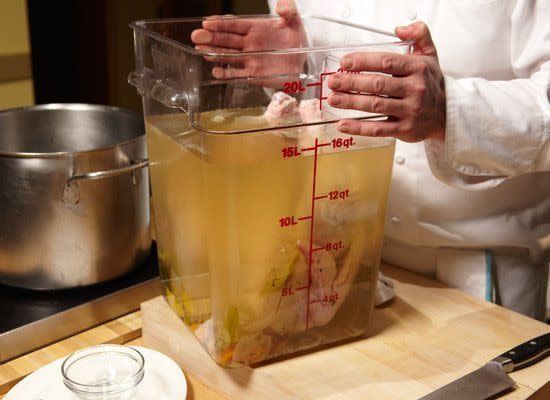
Aimee Herring
Problem: The turkey is dry and flavorless.
Solution: Because turkeys are usually a very lean bird, and previously frozen turkeys tend to lose their moisture when you defrost them, it's important to boost the flavor. Brining is the best answer. A brine is basically water seasoned with salt, herbs and/or spices -- use it to add flavor and moisture to your bird. It may take a little extra work, but brining a turkey overnight allows the bird to absorb all the flavor out of the brine. Then just discard any remaining liquid and pat the turkey dry before preparing it for the oven.
Basting is the second-most important thing you can do to keep the turkey from drying out. After the turkey has been roasting 1-1/2 hours, begin basting the turkey with a hot stock flavored with wine and herbs (you won't have any drippings yet). Once the bird begins to give off juices, use those drippings to brush the bird periodically, about every 30 minutes. Eventually, you'll get great-tasting pan drippings, which you can use to make gravy. Be sure to stop basting at least an hour before the turkey is done to prevent soggy skin. Watch this video for more on basting.
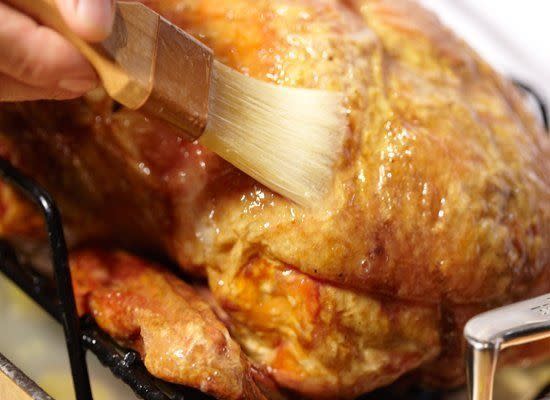
Aimee Herring
Problem: The turkey looks pale and flabby.
Solution: A beautifully browned bird is impressive and tastes pretty amazing. If you're having trouble getting a golden brown skin, there are a few things you can do. Before you put the bird in the oven, rub the skin with soft butter or olive oil -- lots of it. This will help the skin brown better and it will make it taste good. Also, don't forget to baste the bird. Another unique method that helps produce a brown skin is the cheesecloth method. Basically dip the cheesecloth in your basting liquid and drape it over the bird. During roasting, baste the bird as usual -- the cheesecloth will turn almost black. Remove it once the turkey is done and you will be left with the most glorious crackling skin in a shade of mahogany.
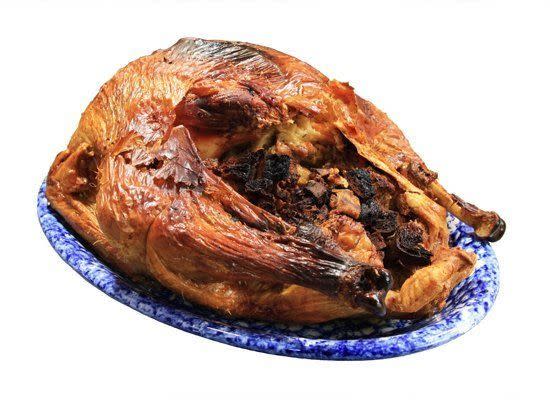
Alamy
Problem: The turkey is burning.
Solution: Aluminum foil is your friend. If you notice that the turkey is browning too quickly, tent it with aluminum foil to redirect the heat away from the skin. You might have to pick off some extra-black skin, but at least you've prevented a disaster.
Some cooks like to prevent this altogether by roasting the bird tented with aluminum foil during the first half of cooking time. Another method is to roast the bird upside down (with the breast down) for the first half of cooking time and then flip it over onto its back to finish roasting, but don't make yourself crazy attempting that with a giant bird.
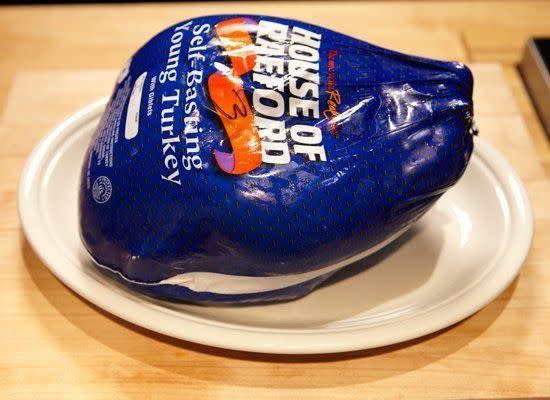
Aimee Herring
Problem: The turkey is still frozen.
Solution: This is a problem, but it happens all the time. What you really needed was a look at a defrosting chart before the big day -- some birds take days to defrost -- but if pressed for time you can always turn to the microwave oven.
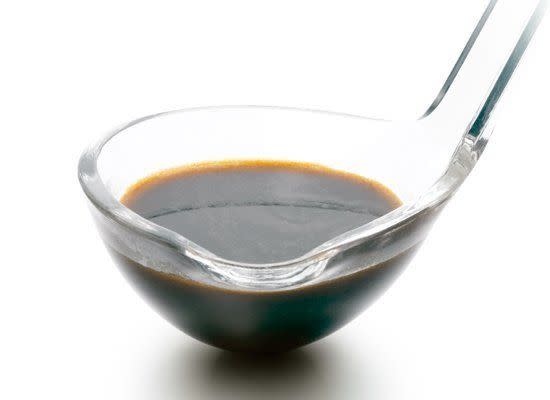
Alamy
Problem: There aren't enough pan drippings to make gravy.
Solution: This is a travesty and a result of not basting properly. (This might occur when you're roasting just a breast and not the entire bird.) In other words, don't forget to baste!
You can always make a stock out of the giblets and neck. Use the stock for moistening the stuffing and for making gravy. See this video on how to make gravy.
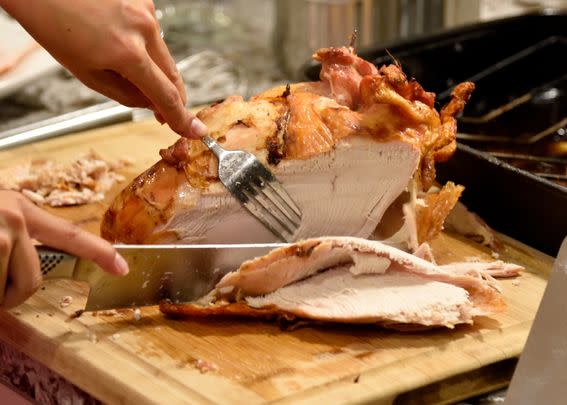
Richard Theis / EyeEm via Getty Images
Problem: The turkey is cooked unevenly.
Solution: An unevenly cooked turkey is almost always a result of not trussing properly -- or an oven that doesn't cook evenly.
Large poultry should always be trussed (i.e. tied up). All the technique requires is tying up the turkey with kitchen twine. This ensures even cooking because it pulls the wings and legs toward the body of the bird, preventing them from splaying outward. This allows the hot air in the oven to circulate easier
If you believe your oven doesn't heat evenly, try rotating the roasting pan a couple of times during cooking. And use an oven thermometer to tell what the temperature is. The oven should be set to between 325 and 375 degrees F.
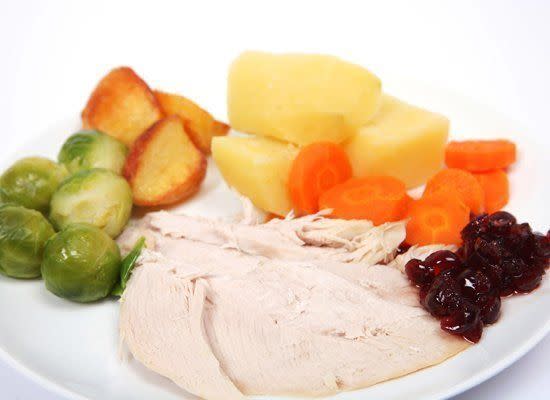
Alamy
Problem: The turkey is undercooked.
Solution: Turkeys come in all shapes and sizes, which means each one will have a different cook time. Choose the bird that's the best fit for the size of your gathering. Click here to see a guide.
And don't rely on the exterior of your turkey to tell that it's done. You should always take its internal temperature by sticking the thermometer into the thigh, just between the thigh and the breast -- make sure the thermometer doesn't touch the bone. The temperature should register 160 degrees F. (Don't forget to take the temperature of the stuffing -- it should also register the same.) Take the turkey out and tent it with foil for about 15 to 20 minutes for a small bird and 20 to 30 minutes for a large one. This period of resting allows the juices to redistribute in the bird (and also allows the temperature to come up a few degrees, preferably to around 165 degrees F).
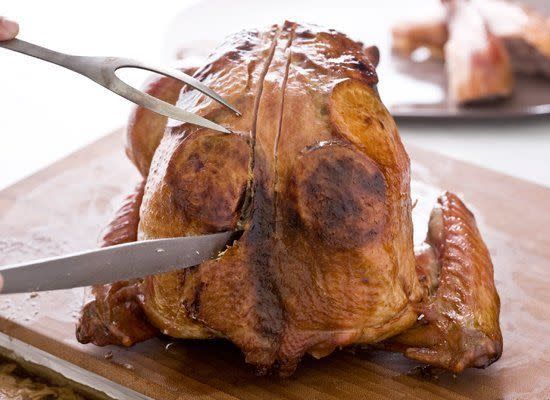
Ray Kachatorian
Problem: The turkey falls apart when I carving it.
Solution: Carving tableside might be impressive, but it's not the best way or place to carve a turkey. You really need a carving board and a good carving knife. To get a good carve, place your bird on a sturdy carving board with a trough to catch all the juices. Start by removing any trussing twine. Begin by removing the leg, the wings and the breasts. The meat should be sliced across the grain on a diagonal to make eating easier. See a step-by-step guide on how to carve a roasted turkey here.

Alamy
Problem: Not sure what to do with the innards.
Solution: Whatever you do, don't forget to remove the gizzards, heart, liver, kidneys and neck from the turkey cavity. You don't want to roast the turkey with the innards inside (especially if they're in plastic bags!).
Instead, use them to make stock, which in turn can be used for moistening stuffing or for gravy. Some people choose to roast or saute the giblets and neck beforehand and then make a stock from the roasted meat. This will give you a much deeper flavor. Make sure not to roast the liver or include it in your stock -- liver will turn your stock cloudy. Chop the liver and add it to the stuffing, for extra heartiness.
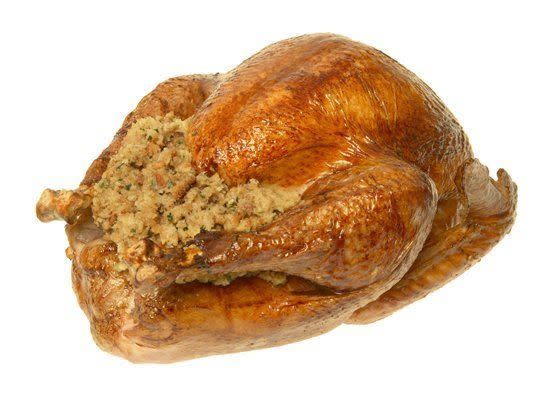
Alamy
Problem: To stuff or not to stuff?
Solution: Stuffed turkey is traditional, but that doesn't mean you have to stuff your bird. Many people actually prefer stuffing or dressing baked separately from the bird. It can actually develop a nice crust instead of remaining soggy which happens when it's cooked inside the bird.
If you've chosen not to stuff, know that the bird will roast faster, but don't leave the cavity empty. Add some herbs, maybe half a lemon, and/or an apple -- these aromatic ingredients lend the bird lovely flavor. If you've chosen to stuff the bird, make sure you do it just before the turkey goes into the oven, otherwise, if done too early, the stuffing will absorb bacteria from the cavity. Make sure to pack the stuffing loosely -- do not compact the mixture or it won't cook properly. Take the temperature of the stuffing, not just the bird. The temperature should register between 160 and 165 degrees F.